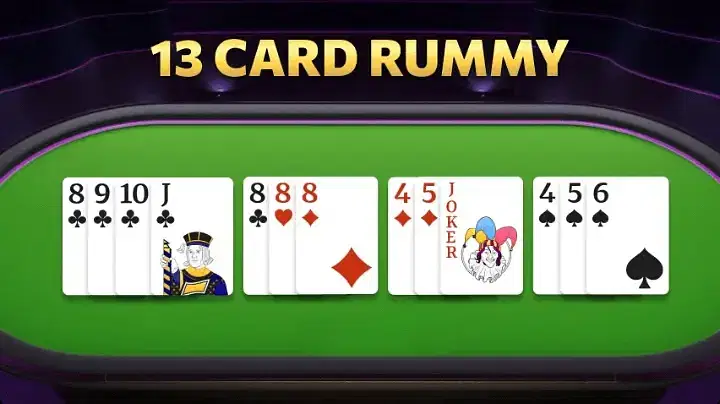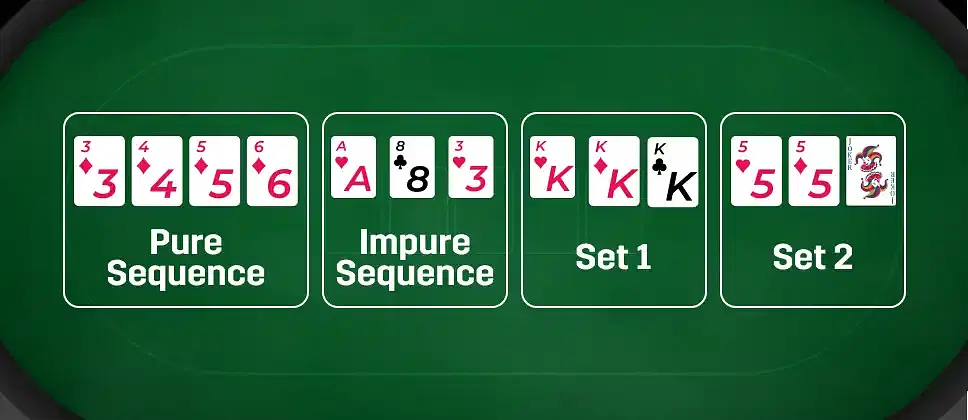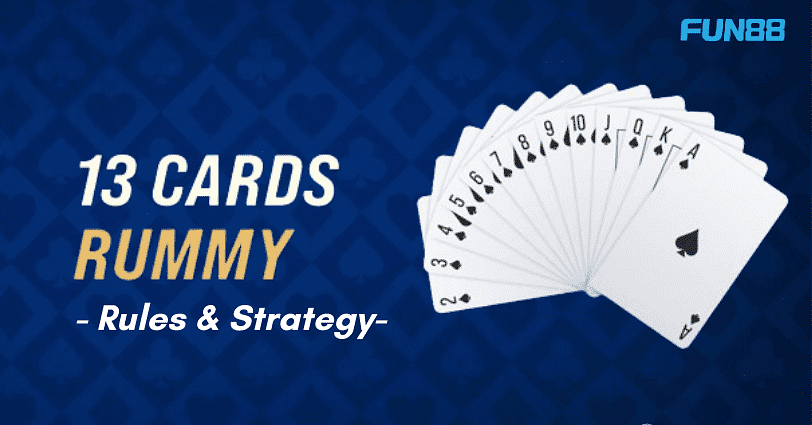Catching up with family and friends often involves playing games, and card games remain a perennial favourite. Now, with the convenience of online gaming, 13 Card Rummy brings the fun right to your fingertips, making it hugely popular in India. With its engaging gameplay, it offers an opportunity to connect and compete, whether you’re at home or on the go.
In real-money games, the ultimate goal is to defeat your opponents and score the most points. To achieve this, mastering strategies that enhance your gameplay is crucial. The essence of this game lies in establishing dominance, putting yourself in the lead and limiting your opponents’ scoring possibilities. Next time you dive into a game, these 13 Card Rummy Rules and Strategies will be your allies, empowering you to dominate and emerge victorious.
In rummy game, the aim is dominance, which places you ahead of your opponent, denying them opportunities to earn more points. So, next time you play, use these strategies to dominate the game.
13 Card Rummy Rules

Dominating the Fun88 13 Card rummy means understanding all aspects of the game, from the basic rules, terminologies, and technicalities. Learning the intricacies of rummy gives you an edge over your competitors. First, you play the online rummy game using a standard deck of 52 cards. Then, the objective is to form sets or sequences by melding the cards dealt to you.
A set is a hand with three or four cards of the same rank with different suits, while a run has three or more consecutive cards of one suit. For example, three kings or four Jacks create a set, while 6, 7, and 8 of spades create a sequence.
Now, check out a few terminologies you must remember while playing.
- Dealing Cards
After shuffling the cards, the dealer gives each player on the table 13 cards per the 13 card rummy rules. You will use these cards to form valid rummy sets and sequences. The remaining cards will be displayed face-down on the stockpile, except the top card, which will be turned face-up. This card is on the discard pile.
- Drawing and Discarding
On your turn, you can draw a card from the stockpile or pick the top card from the discard pile. Your turn ends when you place a card on the discard pile with the face-up. This means the card is available for the next player to pick.
Also Read: Top 10 Winning Tricks of Gin Rummy Card Game Online
- Melding and Laying Off
After you and your opponents collect cards from card games, you can place them on the table facing up to create a meld. Alternatively, you can add cards to existing melds, a move known as “laying off”. For instance, if there is one sequence with 4, 5, 6 and 6 of Hearts, you can lay off a 3 of Hearts to extend the sequence.
- Joker and Wild Cards
In 13 card rummy rules, the Jokers are used as wild cards and substitute any chosen card. It is a valuable asset for creating melds only when substituting cards in sets or runs.
Basic Tips and Tricks for Dominating 13 Card Rummy
Now that you know all the terminologies, it’s time to go over strategies that will help you dominate and win the game.
- Card Drawing Strategy
When the game starts, be strategic about the cards you draw. Observe the cards your opponents discard and decide whether to pick from the stockpile or discard pile. If another player discards a card that will complete your sequence, grab it immediately. While doing this, be cautious about discarding cards that would give your opponents an advantage.
- Form Pure Sequences
The best way to dominate 13 Card rummy is by forming pure sequences a few minutes into the game. A pure sequence is needed to make a valid declaration, and getting one sooner minimises the chances of being penalised.
If the dealer gives you cards that can form a pure sequence, use them before moving to other sets and sequences. For example, if you are dealt with 7♠, 8♠, 9♠, 2♣, 3♣, you can form a pure sequence with 7♠, 8♠, 9♠.
- Practice Rummy Frequently
Practice always makes perfect, especially when you are a beginner. Explore as many rummy versions during practice as you can so you understand the similarities and differences. Practising helps you master the art of evaluating your options, identifying potential melds and making quick decisions.
Consider practising on demo games or against skilled players to develop a winning mindset. Through practice, you will also learn hand management, melding, laying off, discarding, and bluffing to keep your opponents on their toes.
How to Form Sequences?

Forming sequences is the cornerstone of success in 13 Card Rummy. By understanding this aspect, players can effectively streamline their approach and significantly improve their chances of winning. Here’s how you can form sequences strategically:
- Form Pure Sequences
In Rummy, a pure sequence is vital for a valid declaration and guards against penalties. Prioritise forming pure sequences early in the game. This involves arranging three or more consecutive cards of the same suit. For instance, if your hand includes cards like 7♠, 8♠, 9♠, or even 2♣, 3♣, aim to use these cards to create a sequence, such as 7♠, 8♠, 9♠. A pure sequence does not rely on jokers, making it a solid foundation for your rummy strategy.
- Utilise Jokers Wisely
While pure sequences don’t allow jokers, they become invaluable when forming impure sequences. Jokers can substitute for any other card, helping you complete a sequence that’s not possible with your existing hand. Use them judiciously to turn a potential disadvantage into a strategic advantage.
- Discard High Cards Early
High cards like Kings, Queens, and Aces can weigh your score if not part of a sequence. Discarding them early is prudent unless they can be incorporated into a sequence. This reduces the potential points you might lose if the opponent makes a declaration.
- Keep Track of Discards
Observing your opponents’ discards can provide clues about their strategy, allowing you to adjust your game plan accordingly. It’s a subtle aspect of Rummy that, if mastered, offers you a strategic edge over seasoned players.
- Adapt to the Flow of the Game
Flexibility is key in Rummy. As the game unfolds, be prepared to shift your strategy. If one path to forming a sequence seems blocked, reconsider your card arrangements and pivot to new opportunities. This adaptability will keep you competitive, even if your initial strategy doesn’t pan out.
Advanced 13 Card Rummy Strategy
Once you play online rummy games enough times and learn the basic strategies, you can use them as building blocks for advanced game strategies. Advanced rummy strategies revolve around drawing, discarding and melding, but on a deeper level where you can tactically dominate the opponent.
- Read your Opponents
Mastering the ability to read your opponents is a vital skill that will make you dominate the game. Beyond observing the cards they discard, look at their playing style, preferences, and tendencies to gauge their potential moves. Players who are cautious and conservative will hold their cards and play defensively.
Others will play more aggressively, constantly discarding and picking cards to complete their melds quickly. Tracking these different styles helps you adapt your strategy. For instance, going defensive against a reckless opponent to minimise your losses instead of pursuing melds.
Additionally, recognising patterns in how the opponents draw cards is essential for complete dominance. If an opponent picks specific cards in the stockpile, it suggests a strong need to have them in their meld. Using this information, strategically determine which cards you should discard to limit your opponents’ options and gain a tactical advantage.
- Bluffing and Misdirections
Bluffing and misdirection are powerful tools. By bluffing, you give the opponents false information about the cards you hold, leading them to make suboptimal decisions. One way to successfully bluff the opponent is by discarding a high-value card early in the game to show that it’s unhelpful.
They fail to realise that you could be strategically holding onto another card of similar value, waiting to complete a set or sequence. As a result, this calculated misdirection will prompt opponents to drop cards that will help you actualise your strategy.
Bluffing pays off when other players consider you a consistent and rational player. Even if you have an established pattern of discarding and drawing cards, an occasional bluff disrupts an opponent’s expectations, leaving them unsure about your moves.
Also Read: Don’t Miss Out – Check Out Exciting Points Rummy Game too!
- Practice Safe Discarding
Being a pro at discarding is paramount for dominating the table. While discarding is simple, a well-timed discard makes a significant difference between a win and a loss. Practising safe discarding is advised to ensure you only have cards that will help create a winning set or sequence.
The discard pile is a treasure trove of information when you play online rummy games. First, before you place a card on the discard pile, evaluate the cards already placed there. If you notice that your opponents have discarded many cards of a particular suit or rank, it may signal that they are not interested in using them. In such a situation, you can safely get rid of cards of the same suit or rank without worrying about giving opponents a boost.
Secondly, safe discarding also entails keeping cards near the melds you are working on to maintain control over the opponents. Instead, focus on discarding unhelpful cards in creating melds or runs in the ongoing round.
- Consider Grouping Your Cards
Grouping the cards you deal with is one of the most effective strategies in this game. Organising these cards strategically increases your chances of melding and dominating your opponents. There are a few card grouping techniques you can use. For instance, “same suit grouping” where you group cards of the same suit.
Same-suit grouping allows you to identify potential sets and sequences easily. For example, you can group 4♠, 5♠, 6♠ to create a potential run. Besides “same suit grouping,” you can explore “numerical grouping”, where you group cards from different suits but with the same numerical value. For example, if you have 6♥ ,6♦ , and 6♣ , you can group them to make a set and track the cards you need to meld.
Having a card grouping technique enhances your gameplay to make informed decisions and increase your chances of winning at the table. Remember to remain adaptable and flexible to adjust the card groups as the game progresses.
- Use Jokers and Wild Cards to Your Advantage
Joker cards are game-changers in 13 Card rummy because they instantly transform your hand and boost your chances of making winning sets and sequences. You can use a joker card to fill in missing cards in a sequence. For example, if you are dealt a 5, 6, 7 and a joker, use the joker as an 8 to complete the sequence.
Dominate the table using the joker if you have a long sequence with one missing card. Alternatively, you can use the joker to substitute a missing card when creating a set. If the dealer gives you 4, 4, 4 and a joker, the joker will act as a 4 to complete the set.
Depending on the game’s trajectory, you may hold onto your jokers until you clearly understand your hand. As a result, you will find it easier to pick sets and sequences worth using the Joker.
- Harnessing the Power of Melding and Laying Off Cards
Rummy is a simple and easy-to-play game, but knowing how to meld and lay seamlessly differentiates between a beginner and an experienced player. Melding is the foundation of the rummy game because you form sets and sequences to reduce the cards you have at hand and score points. Besides discarding unwanted cards, melding lets you lay off cards later in the game.
Mastering melding and laying off requires constantly scanning the table for opportunities by tracking the cards your opponents pick and discard. Doing this allows you to identify missing cards and use high-value cards to earn more points. Getting more points ahead of your opponents gives you room to strategise laying off without giving the opponent an advantage.
- Learn How to Manage Your Hands
Hand management is a technique experienced 13 Card rummy players use, and you can try it as a strategy to dominate. The first step in hand management is sorting and grouping cards by their suits and sequences to arrive at potential melds. Additionally, prioritise melding high-value cards like Aces, Kings, and Queens to minimise losses and penalties.
For example, if you are dealt a Queen and two Kings of the same suit, make a meld with them sooner. As you meld high-value cards, discard the low-value cards because they will be of little use to you and may help disrupt the opponents’ strategy, giving you an edge.
Remember that hand management is not a one-size-fits-all strategy. You should be flexible and adaptable to changes. During the game, your hand composition and the cards at your disposal will change. Therefore, adjust your hand management techniques to stay ahead in the game.
- Focus on Building a Strong Hand
One key tactic for winning rummy is building a strong hand immediately after the game starts. Therefore, you should try making melds and sequences that are easy to complete while watching out for potential moves. For instance, if you have a sequence of 6 ♥, 7 ♥, 8 ♥, you might be tempted to discard the 6♥ to complete a set of 6s.
However, it is better to hold the card to help you complete a sequence if you draw a 5♥ or 9♥ . Planning makes it easy to dominate and possibly win a hand ahead of your opponents. At the same time, calculate probabilities to help you draw the right cards.
For example, if you have a sequence that needs a 7♠ to be complete, you can calculate the probability of drawing the same card by assessing the spades already in your hand and those already discarded. Also, check the number of unknown cards in the deck and calculate your moves before the opponents catch wind of what will hit them.
When playing online rummy, always approach it with the idea that all your opponents are experienced players. This helps you master key strategies to dominate them because you can easily spot their weaknesses and strengths by how they play. With practice and constant learning, you can easily dominate the 13 Card rummy tables with strategic card draws. Hopefully, the rummy game rules and strategies above will help you become a better rummy player who can read opponents and bluff them swiftly without the risk of losing.
Common Terms Used in Rummy Rules

Understanding the common terms in Rummy adds depth to your gameplay and helps you communicate strategies more effectively.
- Meld: This refers to grouping cards to form a sequence or a set. A meld is crucial for making a valid show.
- Deal: The act of distributing cards to players at the start of the game. The dealer plays a crucial role in setting the initial conditions of the game.
- Drop: A strategic move is when a player chooses to quit the game initially or halfway, incurring fewer points as a penalty than staying in the game with a poor hand.
- Show: When a player has completed the required sequences, they can declare a show to present their hand for validation and scoring.
Conclusion
13 Card Rummy offers a thrilling blend of strategy and chance, making it a popular choice among card game enthusiasts. By mastering the 13 Card Rummy Rules and Strategies, understanding the nuances of forming sequences, and utilising effective strategies, you can significantly improve your gameplay and emerge victorious in this captivating game. So, gather your friends, dive into the world of 13 Card Rummy, and let the fun begin!
Star it if you find it helpful.

